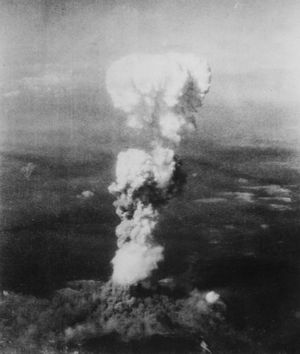On August 6th, 1945, a single B 29 bomber flew over the Japanese city of Hiroshima and dropped a single bomb. Seconds later, a nuclear explosion snuffed out the lives of eighty thousand Japanese in an instant. The nuclear age had begun.
A hundred thousand more Japanese would eventually die of burns, shock, radiation poisoning, and other after effects of the Hiroshima bomb. Similar casualties would ensue at the dropping of the second atomic bomb over Nagasaki a few days later. Soon after, the Japanese Emperor called upon his Army and people to surrender.
Almost from the moment the mushroom clouds of the nuclear explosions had dissipated, the debate has ensued around the question: Was the atomic bombing of two Japanese cities necessary? In an article for the Wall Street Journal, Warren Kozak offers an analysis of the divide between those who say yes and those who insist no.
“Today, Hiroshima has become a Rorschach test for Americans. We see the same pictures and we hear the same facts. But based on how we view our country, our government, and the world, we interpret these facts in very different ways. ”
Actually, the facts point toward the inescapable conclusion that the nuclear bombings of Hiroshima and Nagasaki were necessary to forestall an invasion that would have taken the lives of millions, Japanese and Allied. Even with the nuclear bombings, it was a near run thing. A group of Japanese military officers tried to abduct the Emperor to prevent him from making the surrender broadcast.
To understand why the United States resorted to the nuclear bombing of Hiroshima and Nagasaki, one has to look back at the Battle of Okinawa that took place from March to June in 1945. To call Okinawa a blood bath is to put the matter mildly. When the battle was over, 12,000 Americans-thrice the number killed so far in the War on Terror-had been killed in action. 110,000 Japanese soldiers, nearly the entire garrison, were dead. Civilian death estimates range from 40,000 to 145,000.
American military planners extrapolated the casualties suffered and inflicted on Okinawa to what was expected to happen in the planned invasion of Japan. The estimate of the cost of finally putting Japan down frightened even the most hardened military officers to their core.
The sort of things contemplated by military planners for the invasion of Japan seem like madness to someone examining them decades later. The use of nuclear bombs as tactical weapons and even of poison gas was seriously considered. Even without those weapons of mass destruction, the Invasion of Japan would have been the bloodiest battle in world history.
Fortunately the nuclear bombing of Hiroshima and Nagasaki provided the shock that was needed to induce the Japanese Emperor to ask his people to “endure the unendurable” and surrender. Japan thus emerged from the war a defeated country, but a country nevertheless and not a wasteland.
Millions of nineteen and twenty year old soldiers, whether American and allied being gathered from as far as the European battlefields to hurdle themselves on the invasion beaches on Japan, or Japanese who were dug in, waiting for them, would now live to marry, have families and civilian careers. Their children would grow up and have their own children. A generation did not die in late 1945 and early 1946.
Looked at it another way, Hiroshima and Nagasaki prevented another Holocaust that would have rung down the curtain of World War II and would have haunted the world ever since.
Source: The Hiroshima Rorschach Test, Warren Kozak, Wall Street Journal, August 6th, 2009

